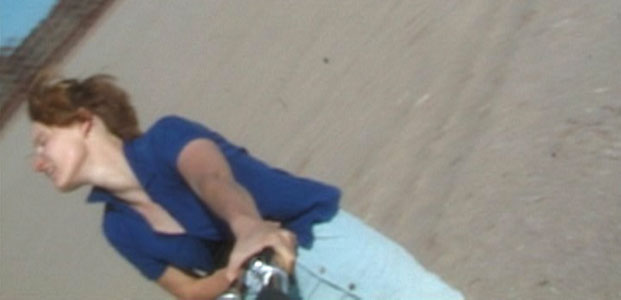Astrid
Nippoldt | Martina Schumacher
UNIVERSAL PICTURES
Nov 13 - Dec 22, 2004

At the end of the universe we see ourselves
In
the past the road led "from the closed world into the infinite universe,“
as the French historian of science Alexandre Koyré wrote in 1957.
Koyré was examining the development from the Middle Ages to the
Baroque, a development which was determined in optical terms through the
invention of artistic perspective and of new astronomical instruments.
A gaze into the distance, which on earth always ends at the horizon, could
be expanded through a telescope to reach to the farthest stars.
But where is the observer? Is he located "inside“ and does
he look through an "open window“ into the picture before him?
Or is it the picture that lies within, and does the observer gaze into
it from the outside? This separation of observer and image (at least within
one and the same universe) is already problematic when the image is conceived
of not as a window, but - as in Dutch painting — as a mirror. In
this case the space visible within the image becomes a duplicate of the
area in front of the image in which the observer finds himself.
New theories regarding cognition have more closely analysed the complex
and nearly paradoxical relationship between perceiving and being perceived.
Heinz von Foerster, a pioneer of radical constructivism, formulated the
question as follows: "Am I separate from the universe (in other words,
do I look through a peephole at the universe unfolding before me) or am
I a part of the universe (in other words, whenever I speak of the universe,
am I also talking about myself)?“
Von Foerster considered a final answer to this question to be an impossibility.
However, unanswerable questions bearing on perception are the domain not
only of scientists, but above all of artists. In very different ways,
Astrid Nippoldt and Martina Schumacher demonstrate that the instruments
used to perceive and record visible phenomena cannot be separated from
perception itself.
Astrid Nippoldts video "The Serendip Stadium“ shows scenes
from a racetrack during a snowstorm. The image becomes less and less clear
whenever the camera draws closer. Snowflakes become long glittering streaks,
a horse’s coat and tack appear to be the body and strings of a violin.
The moving images of the film "transport“ us to various levels
of visibility. The sequences have an almost impressionistic affect and
recall the period during which still images "learned to move“
– not the least because they depict horses, whose course of movement
was first made visible through Muybridge’s sequential photographs.
"Bloop“ presents a universe in which all movements seem slowed,
as if under water. An arm is supported as if on the edge of a basin, yet
the spatial context for the images become increasingly unclear. What in
the next case first appears to be the surface of the moon reveals itself
to be sand, on which the artist herself is running. Was the blue in the
foreground the sky all along?
In "Heroic Turn“ the artist performs convolutions ranging from
remarkable to obscene with a stand-mounted camera. An exterior force seems
to draw her out of the picture. Likewise, the camera achieves no detachment,
no independent position for observation. Instead, something constantly
seems to be wrestling for control over it.
Detachment also plays a significant part in the work of Martina Schumacher. Her large format pictures are composed of thousands of sequins. These small colorful round metal plates with a hole in the middle were most often sewn onto clothing during the reign of the glitter-disco style. The original motives – the artist’s own photographs, illustrations from magazines and books or pictures from the Internet – are scanned and, using a computer program developed by the artist especially for this purpose, "analysed.“ The program decides which of the 45 possible sequin colors will be used at each point in the new rendering of motive. The contours of the original motives, which are spread over the sequins as if dissolved into pixels, coalesce only when one stands at a certain distance from the image. Whether a portrait, an ice-covered mountaintop, or the branches and leaves of a tree, the motives drawn from day-to-day experience can all be identified from the appropriate external point. The views of a "supernova,“ three of which appear in the exhibition, could be just as easily understood by the uninitiated as the interpretation of a microscopic image of the corpuscles. As in the work of Astrid Nippoldt, a disturbing, ambiguous play with scale, dimensions and the combination of elements takes place. Martina Schumacher, a self-declared "supporter of beauty,“ lays particular weight on the exquisitely glittering surface, from which new affects continuously emerge. This is due not only to changes in the light: the sequins, suspended on nails at a slight distance from the background, move as soon as one passes close to the image or when a breath of air touches them. The space within the image and the space of the observer have an effect on one another.
The universe of images, which flows over us day after day, seems to be infinite
and to include everything that can possibly be captured visibly. It is easy
to forget that clear visibility only emerges as a result of certain exterior
and subjective circumstances. What is more probable is that we see things
indistinctly, unclearly, only partially or not at all.
What holds true for the world of images is also the case for our perception
of the cosmic. The visible universe is only a small part of a much larger
one, which is not (or not yet) available to our perceptive capacities. In
the end, as one comes closer, perception leads back to one doing the perceiving.
If you stand close to a picture by Martina Schumacher and direct your gaze
to a single sequin, you will see the reflection of your own eye.
Ludwig Seyfarth